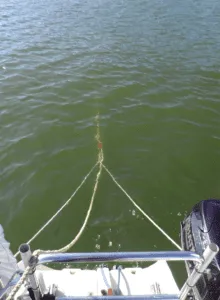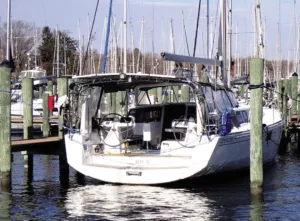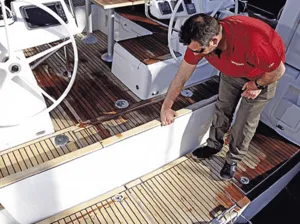Sailboats yaw at anchor. In prior reports we discussed seriously yawing can compromise anchor security, and we talked about how a riding sail can calm this motion by altering the balance of forces (see “Yawing and Anchor Holding” PS February 2020 and “Rest Easy with a Riding Sail” PS August 2019). Both cruisers and researchers have noticed that most boats sit quietly when anchored by the stern; the center of windage is forward of the center of underwater resistance, which is stable.
Donald Jordan, inventor of the Jordan Series Drogue and noted heavy weather researcher, went so far as to suggest that in certain circumstances, a boat might hold more securely in a storm if it were anchored from the stern. Yawing is virtually eliminated, reducing the wind load and minimizing side-to-side forces on the anchor. But search as we might, we could find no data to support this argument.
The most obvious problem with this approach on most boats is the vulnerability of the rudder, cockpit, and companionway to breaking seas.
WHAT WE TESTED
To test the hypothesis that wind and sea loads could be reduced on a boat that is anchored stern-first, we dug out our handy dynanometer and went to work. We anchored by bow and stern, comparing yawing, wind load, motion, and livability. We tested with two multihulls, which are generally more prone to yawing—our F-24 trimaran and a PDQ 32 cruising catamaran.
HOW WE TESTED
We anchored by the stern with a very short bridle and by the bow with a long bridle; this rigging results in similar yawing behavior, allowing us to compare rode tension in isolation from any variation in yawing patterns. The bottom was firm sand and the rode was 3-strand nylon at 7:1 scope. Wind varied from 10-30 knots over two days of observation. Waves in the sheltered anchorage were minimal.

Like many contemporary small boats, the test boat has an open transom and could not be safely anchored by the stern in open waters. Rode tension was measured with a load cell.
WIND AND WAVE LOAD
Wind and wave data really need to be broken into two parts; variations that were impacted by the shape of the bow and stern; and variations that were due to the amount of yawing.
Ultimately, when we compared loads at the same angle of yaw there was a 10 percent increase in rode tension when anchored from the stern instead of the bow.
The precise numbers are difficult to pin down, however, since the load rises and falls with time, the boat surges with the gusts, and there is error in both wind and force measurements. To smooth out these variables, we took many readings and averaged the data. In small waves, there was very little difference between loads when anchored from the bow or stern.
It seemed plausible that on some boats, however, yawing would be more pronounced, perhaps over-riding any hydrodynamic issues when anchored from the stern. With a long bridle anchored from the stern, the F-24 trimaran sits very quietly. It yaws about 20-30 degrees, as short-term wind oscillations nudge it one way or the other. We tried to correct for oscillations, but they are often too rapid to distinguish from the yawing caused by the imbalance of forces.
Anchored by the bow without a bridle the boat yawed as much as 140 degrees, and only about 50 degrees when similarly anchored from the stern. When a boat yaws through these extreme angles, the actual load on the anchor is more than two times greater than when the boat sits still (as much 240 percent). This is because as the boat yaws, the greater surface area of the topsides is exposed to the wind.
Anchored by the stern, yawing was reduced to about 20-30 degrees, the same as when anchoring with a long bridle. Thus, anchoring by the stern can significantly reduce rode tension caused by yawing. Keep in mind, however, there are many means to control yawing that can be simpler than stern anchoring—using all-chain rode, raising a riding sail, adding a bridle, a kellet (a weight to induce sag in the road), or hammerlock mooring (a short -scope anchor that drags on the bottom), setting “V” or tandem anchors, or making other adjustments (see “Tandem Anchoring,” PS September 2016 and “Other Methods to Control Yaw,” PS January 2022).

MOTION
Although we tested in sheltered locations with only 6- to 12-inch chop, the difference in the amount of pitching motion between stern and bow anchoring was considerable. When anchored from the bow, the pitching is a milder version of that experienced when sailing to windward; a gentle fore-aft rocking. When anchored from the stern, the motion is much quicker and more irregular. This is the result of waves rising under the broad stern sections, causing the transom to rise quickly. Even small chop was unpleasant.
WAVE NOISE
Anchored from the bow, waves are nearly silent in sheltered waters. Anchored from the stern, there is an audible slap every time a wave hits the transom or underside of the hull. Additionally, since the sound originates from the stern and the companionway is typically open, it is quite audible in the cabin.

WEATHER PROTECTION
On a windless day in a steamy harbor, a breeze coming in through the companionway sounds inviting. Our actual experience has been different. We anchored our PDQ 32 catamaran from the stern a few times over the years, reasoning that with a hard top and open salon, this would funnel more air through the salon than the forward facing salon roof hatches. We thought the aft cabins would be cooler, since the roof hatches faced aft. We were wrong. When anchored from the bow, the large hardtop produces a low-pressure area in the cockpit, drawing air through the cabin more effectively than when anchored from the stern. We tested using an F-24 trimaran, which has a forward-facing hatch over the V-berth and companionway configuration common to small monohulls. Ventilation was slightly better in the aft half of the cabin, but there was less air movement in the V-berth (see “Feeling the Breeze,” PS September 2020).
The most serious downside when anchored stern-to is increased weather exposure. When the PDQ 32 was anchored by the bow, we could keep the salon door open through the most violent hail storm, but even mist was a problem when anchored by the stern.
Aboard the F-24, we can leave the companionway open when anchored by the bow, so long as the mini-dodger is in place, a nice boon in hot weather. Anchored by the stern, rain pours through the companionway every time you go on deck. Both boats are drafty when anchored by the stern in cold weather; even doors that have proven rain-tight admit annoying drafts, and if you open the door, the temperature drops 10 degrees in seconds.
WAVE EXPOSURE
The shape of the transom has an effect on safety when anchored from the stern. For example, the F-24 trimaran has an open transom, and although we tested in protected waters, we know that in open waters waves would roll right into the cockpit. Swamping the cockpit requires fairly big seas, because the boat rises with each wave. As soon as crests begin to break, you can bet they’ll fill the cockpit.
The PDQ catamaran, on the other hand, has relatively narrow transoms and a high bridge deck. Because of its center cockpit design, the minimum height before water can reach the cockpit is nearly 5 feet. Although larger waves can make a bit of noise on the swim platform, the boat is very safe in following waves. Nevertheless, every time we tried anchoring by the stern, we switched back to the bow within an hour.
ANCHOR HANDLING
On a smaller boat with a lightweight anchor stored in a well, such as the F-24, setting a stern anchor is simple. Just carry the anchor down the side deck, outside the shrouds, and deploy over the transom, attaching a simple bridle to the stern cleats. Recovery is even easier: release the bridle, allow the boat to swing bow-to, and recover the anchor in the usual manner.
For boats with chain rodes and windlasses, things are more complicated. One solution is to have a dedicated stern anchor and rode, which is kept in the lazarette.
Your stern anchor weight is restricted by what you can handle manually, including recovery, and the rode must be mostly rope. Handling will usually be manual (cockpit winches are often not oriented to take loads from this direction), and breaking out a well-set anchor is tough. If the main anchor is to be used, we found it simplest to anchor in the usual manner, and then use a long snubber line (about 1.5 times the boat length) secured at the stern to turn the boat. This must then be rigged as a bridle, even on monohulls, which further complicates the process. There is always the risk of getting the rode around wrapped around the keel in the process. The whole endeavor is a nuisance in fair weather and just plain complicated when it’s blowing hard.
STORM ANCHORING
Does your boat yaw in a real blow? If you’ve never anchored in over 40 knots try this experiment. Instead of anchoring with all-chain, anchor with rope-only (no chain) on a breezy day. This simulates the way your chain will lift off the bottom and become ineffective at controlling yawing in storm. Try moving windage aft, adding a bridle or riding sail, or rigging a hammerlock mooring. Two anchors rigged in a broad (90-120 degrees) V will control yawing.
Don’t bother with a kellet; it won’t help in storm conditions, because, like the chain, it too will lift off the bottom. If all efforts to prevent yawing fail, you may want to investigate anchoring from the stern. There have been reports of sailors anchored by the stern through strong storms, including hurricanes. They reported an awful experience, with a terrible up-and-down motion and rain driving through the companionway, but in all cases the anchor held and boat did not yaw. As with all anecdotal tales, there is no way of knowing what would have happened had they been anchoring by the bow.
Based on our testing, we remain doubtful that a stern-to approach to storm anchoring is practical.
CONCLUSIONS
Yawing was greatly reduced by anchoring from the stern. This seems universal. The wind load was not increased measurably by the lack of streamlining, and was considerably reduced by the elimination of yawing. But livability was reduced, especially in wet or cold weather.
We wish we had stern anchoring data from storms, but there is little field experience, and our negative experiences have disinclined us from testing. The numbers tell us it could make sense for a monohull with narrow transom (a double-ender perhaps) that yaws a lot, but most boaters would be wiser to find another solution to yawing, and securing the rudder amidship to prevent damage would be essential.

































So now lets talk real world! Consider a 40′-50′ monohull sailboat, on a bow anchor with a 5:1 scope, and a 25′ snubber attached. and the bow hunts continuously! How do you deploy a stern anchor?? Is a stern anchor a reasonable solution? what scope? does it need a snubber too? how do you recover it (the windlass is in the bow? How heavy a rode is needed?
Not much experiece, but.. Been thinking on this, where med mooring is common there are some anchor holders on sterns ! And to lead rope part back as all chain etc. But reading this the stern anchoring sounds no brainer way to go. Some test on basic monohull please, say Catalina 36, and even some newer design with wider open swim platform. As any stability is good and when conditions are miserable the ‘liveability’ thus should actually increase in all situations, when its good its good, little better who cares, but when its bumby and miserable a bit less miserable would be great actually ? (But as said just thinking, to get to try out in practice).
I feel as though the negatives must not have been clearly communicated. By no stretch is stern anchoring a “no brainer” and in many conditions and with many boats it is probably a terrible idea. That’s whey we anchor from the bow.
There are many other ways to damp yawing (search PS archives). Please exhaust all of those options first. In the first sentence of the summary we said that “our negative experiences disinclined us from further testing.” In no case did we consider stern anchoring to be a net improvement over other good practices.
I used to own a Hunter 410 which has a stand up head forward. The resulting freeboard made the boat hunt (yaw) like crazy in the lightest of winds. The key was using a riding sail. Unlike a stern anchor, a riding sail is simple to set. Moving the center of effort aft made all the difference.